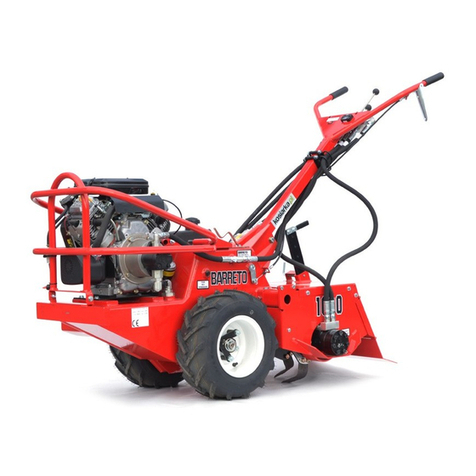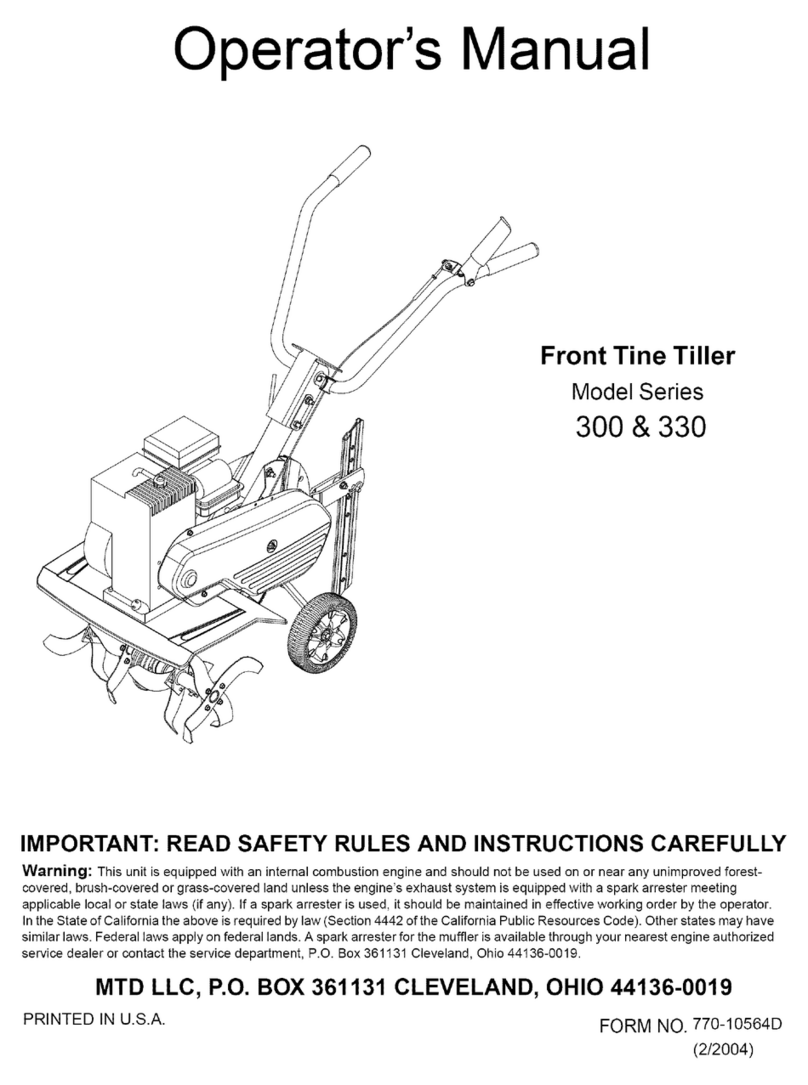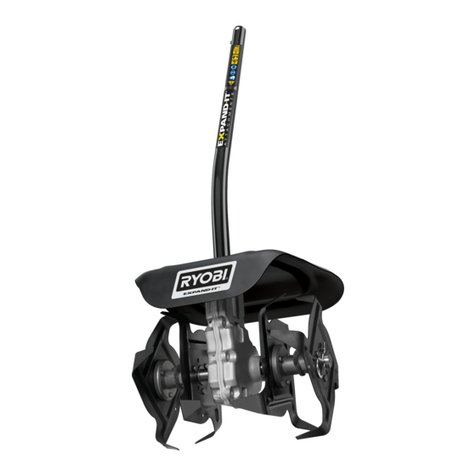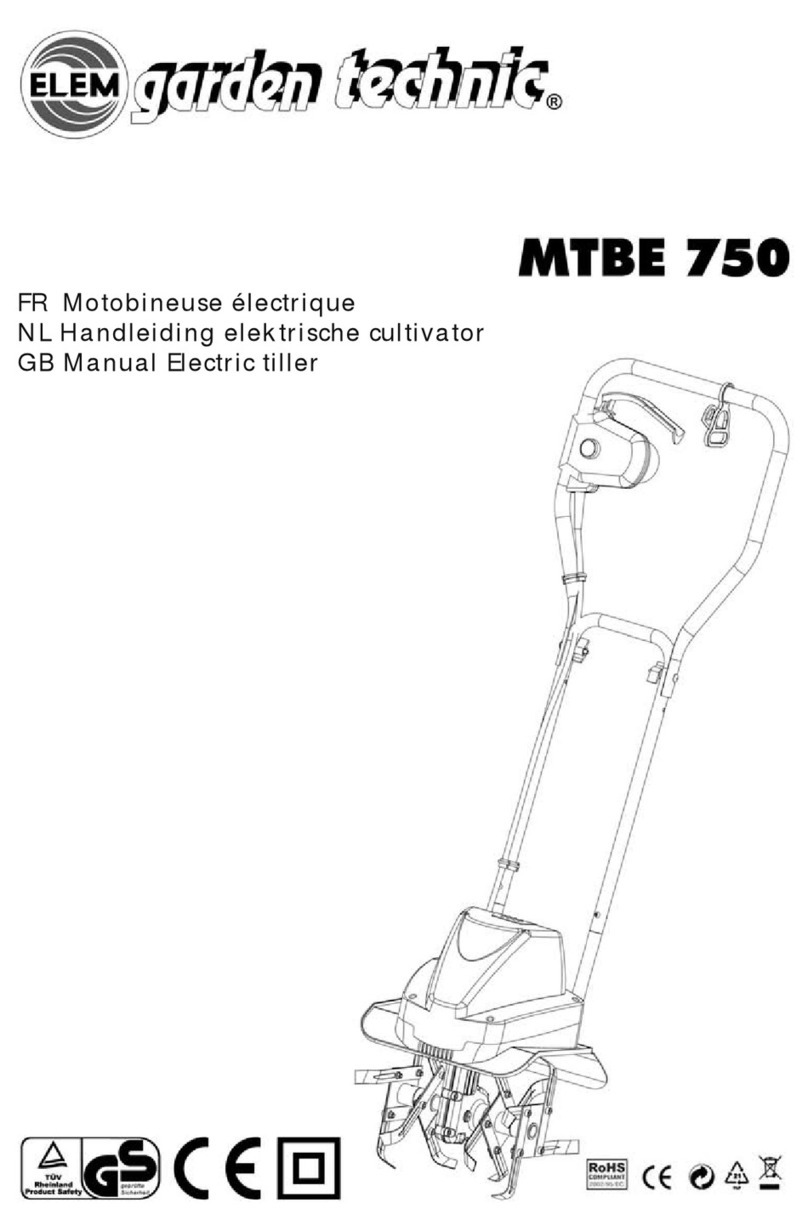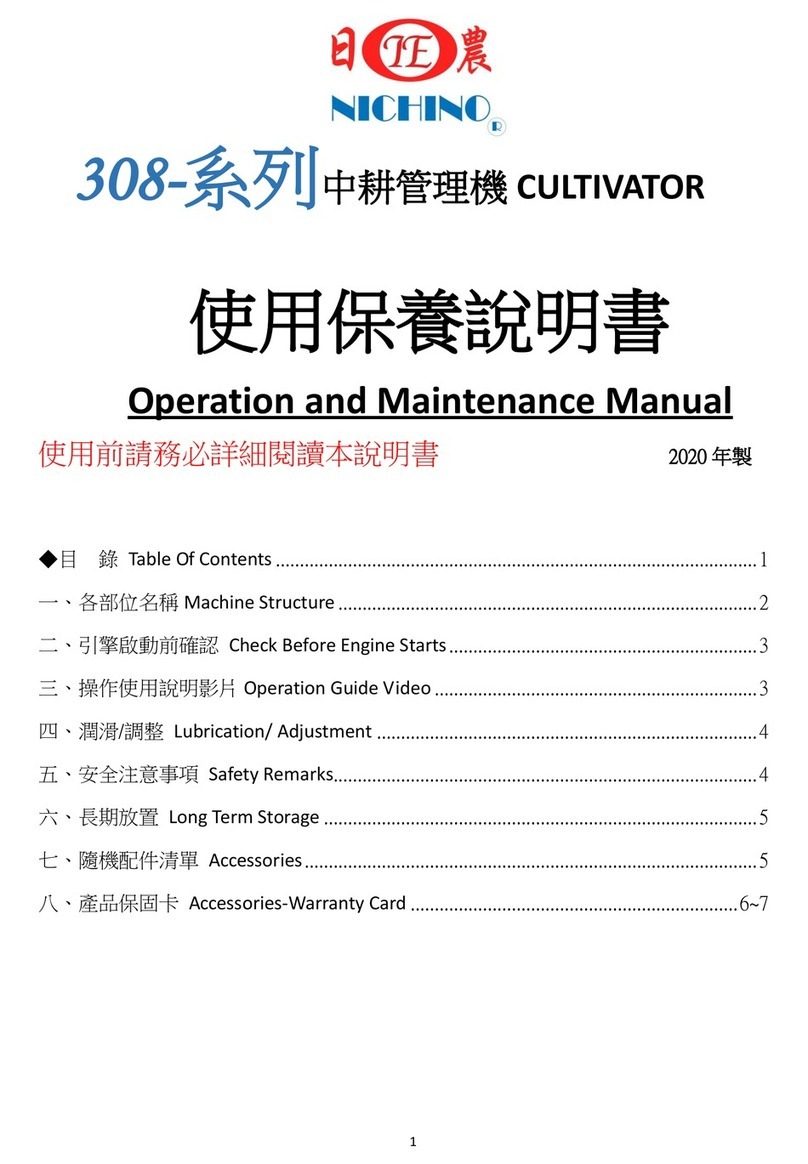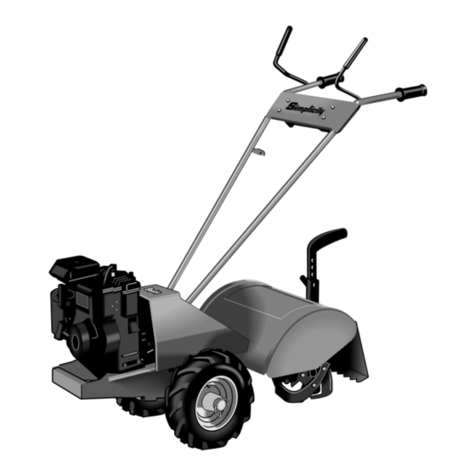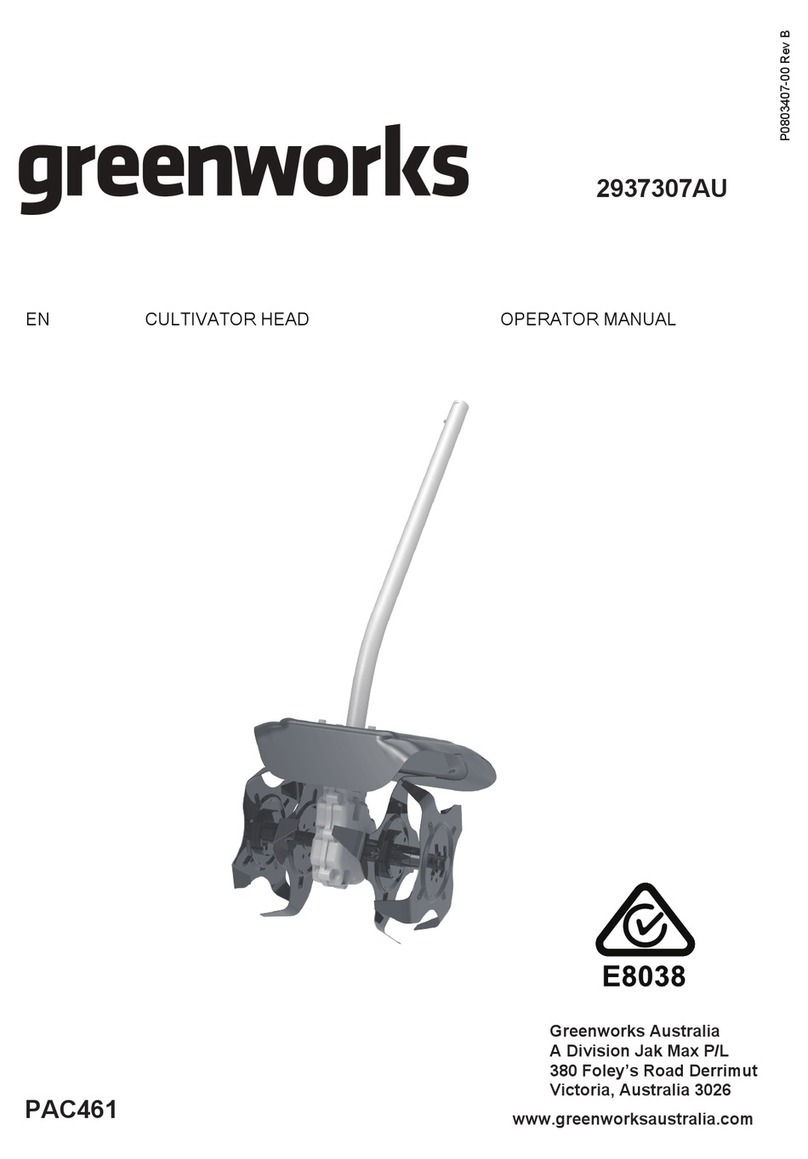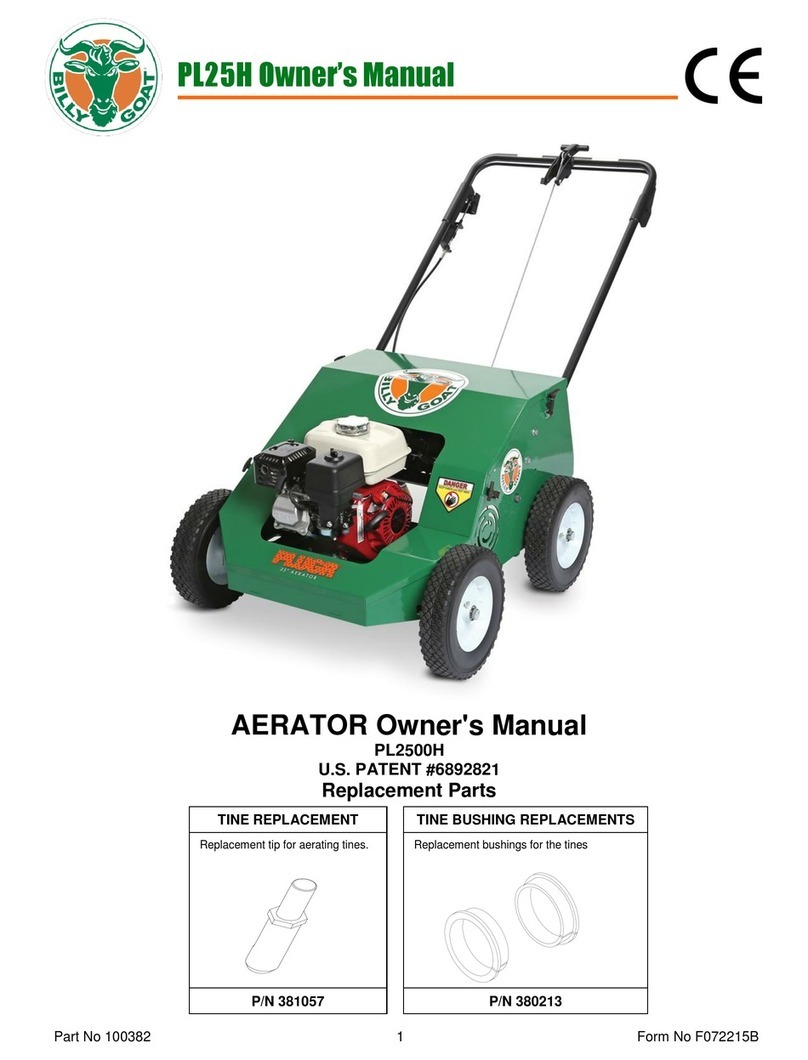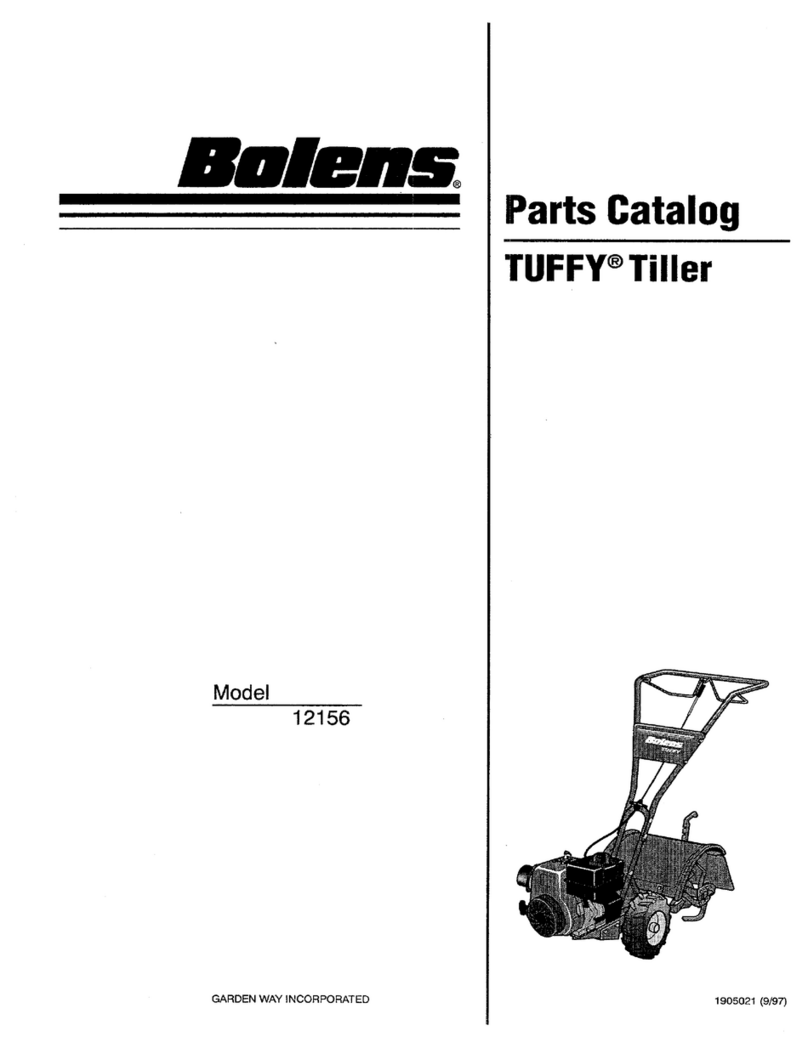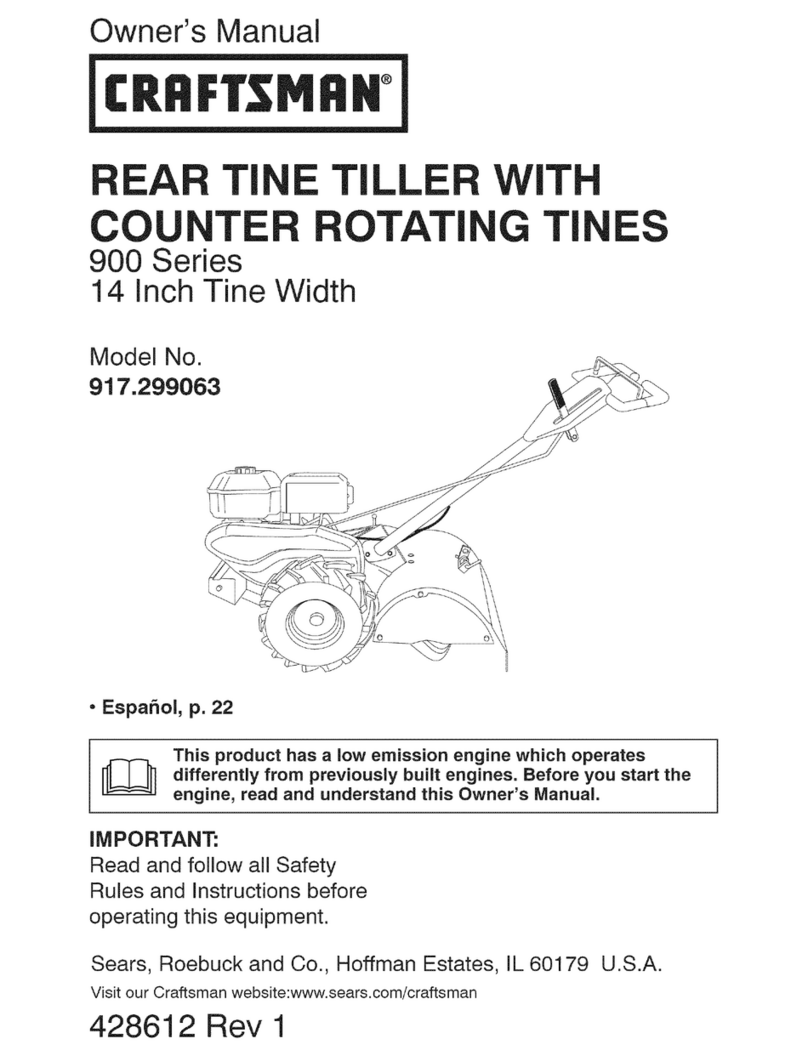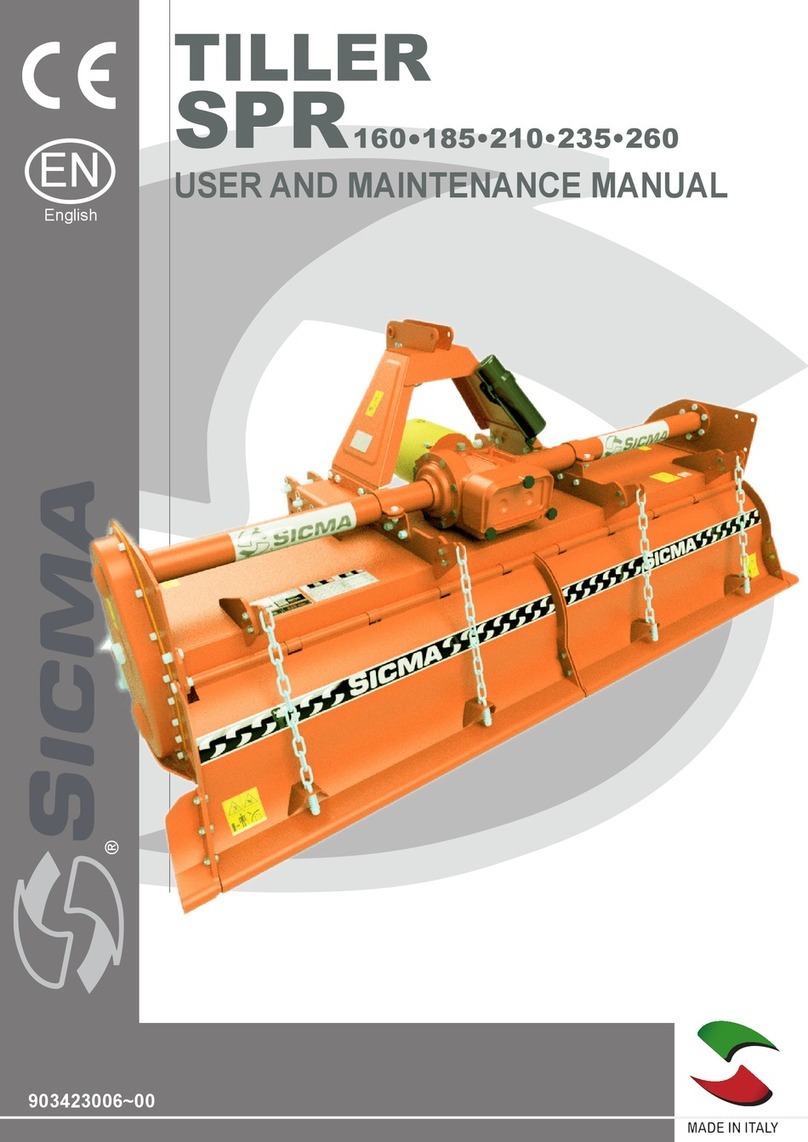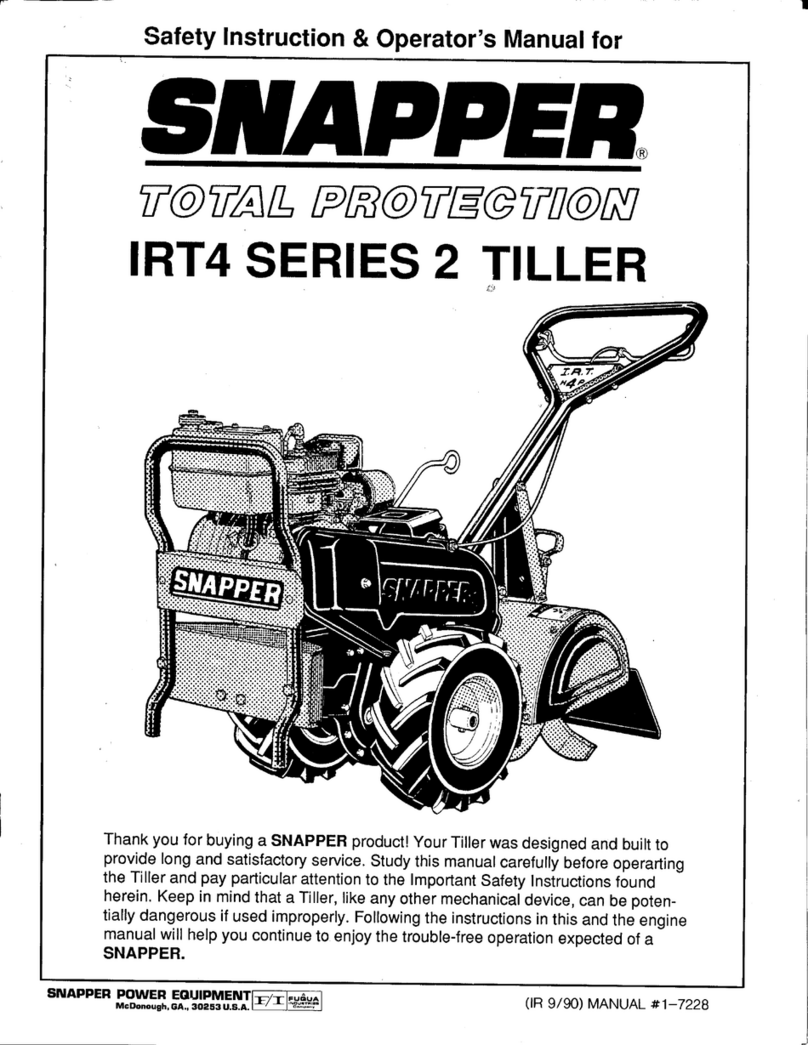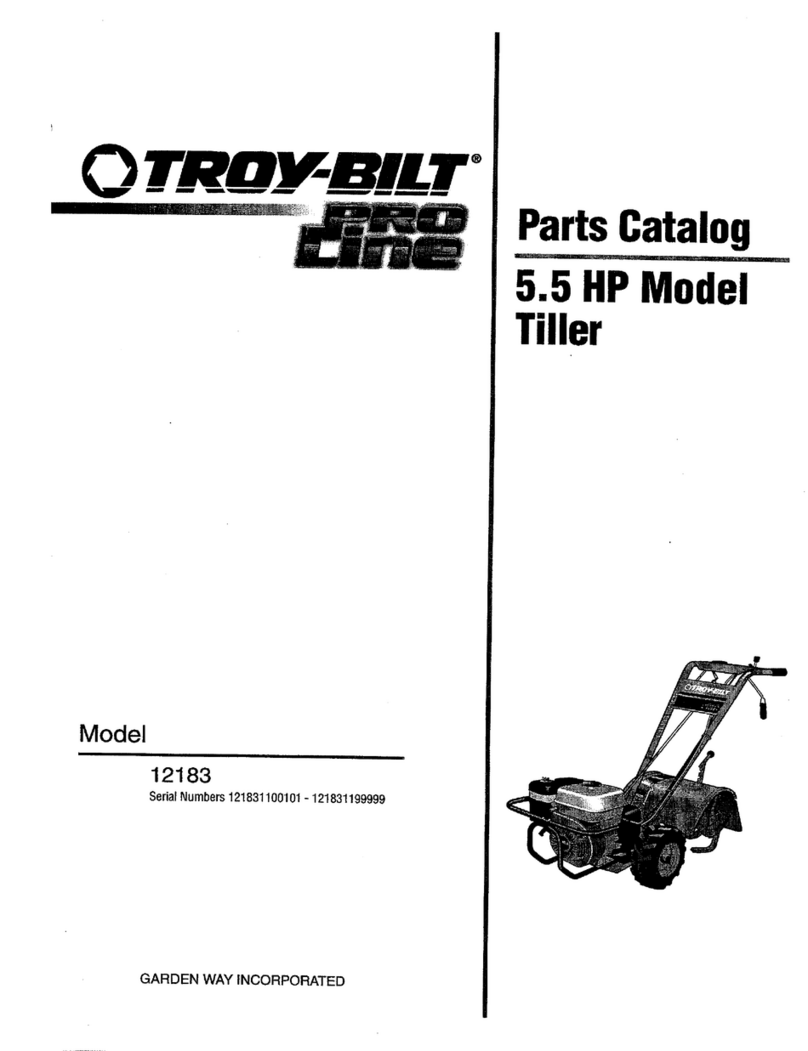HARRISTON INDUSTRIES 2015 User manual

CULTIVATOR
OPERATORS MANUAL & PARTS BOOK
INDUSTRIES
2015
2025


HARRISTON INDUSTRIES, INC.
CULTIVATOR
WARRANTY
HARRISTON INDUSTRIES, INC. (Harriston) warrants the Harriston Cultivator to be free from defects in material
and workmanship, under normal use and service. Obligation under this warranty shall extend for a period of 1
year (12 months) following the date of delivery to the original purchaser and shall be limited to, at the option of
Harriston, replacement or repair of any parts found, upon inspection by Harriston, to be defective.
WARRANTY CLAIMS
The purchaser claiming under this warranty shall submit a warranty claim to Harriston or an authorized dealer, for
inspection by an authorized company representative. Should any part prove defective within one year from date of
purchase, the part will be replaced without charge, provided the defective part is returned to us, transportation
charges prepaid.
LIMITATIONS OF LIABILITY
This warranty is expressly in lieu of all other warranties expressed or implied and all other obligations or liabilities
on our part of any kind or character, including liabilities for alleged representations or negligence. We neither
assume nor authorize any other person to assume on our behalf, any liability in connection with the subsequent
sale of the Cultivator.
This warranty does not cover parts and accessories, which are under separate guarantees from the
manufacturers and service facilities in Canada or the United States.
This warranty shall not apply to any Cultivator which has been altered outside the factory in any way so as, in the
judgment of Harriston, to affect its operation or reliability, or which has been subject to misuse, neglect, or
accident.
No warranty is extended to regular service items such as lubricants, paint, and the like.
OPERATOR’S MANUAL
The Purchaser acknowledges having received training in the safe operation of the Cultivator and further
acknowledges that Harriston does not assume any liability resulting from the operation of the Cultivator in any
manner than described in the Operator’s Manual supplied at the time of purchase.
WARRANTY VOID IF NOT REGISTERED

1
Table of Contents
1 INTRODUCTION .................................................................................................................... 2
2 SAFETY ................................................................................................................................. 3
2.2 OPERATING SAFETY ................................................................................................. 5
2.3 MAINTENANCE SAFETY ............................................................................................ 5
2.4 HYDRAULIC SAFETY .................................................................................................. 6
2.5 TRANSPORT SAFETY ................................................................................................ 6
2.6 STORAGE SAFETY ..................................................................................................... 7
2.7 TIRE SAFETY .............................................................................................................. 7
2.8 ASSEMBLY SAFETY ................................................................................................... 7
2.9 SAFETY DECALS ........................................................................................................ 7
3 SETUP .................................................................................................................................... 9
3.1 TOOLBAR SETUP ....................................................................................................... 9
3.2 MARKING TOOLBAR ................................................................................................... 9
3.3 REFLECTORS ............................................................................................................. 9
3.4 THREE-POINT HITCH ................................................................................................. 9
3.5 GANG ASSEMBLY ....................................................................................................... 9
3.6 ROW SPACING .......................................................................................................... 11
4 OPTIONAL EQUIPMENT ..................................................................................................... 11
4.1 TOOLBAR GAUGE WHEELS .................................................................................... 11
4.2 STEEL GUIDE WHEELS ............................................................................................ 12
4.3 CHISEL MARKER ...................................................................................................... 12
4.4 CHISEL MARKER CLEANER .................................................................................... 12
4.5 HILLER DISCS ........................................................................................................... 13
4.6 SPIDER SHANKS ...................................................................................................... 13
4.6 HILLER DISC SCRAPER ........................................................................................... 13
5 OPERATION & SERVICE .................................................................................................... 14
5.1 ADJUSTMENT & OPERATION .................................................................................. 14
5.2 MAINTENANCE ......................................................................................................... 14
5.3 STORAGE .................................................................................................................. 14
6 TROUBLESHOOTING ......................................................................................................... 15
7 PARTS LIST ......................................................................................................................... 16

2
1 INTRODUCTION
Congratulations on your choice of a Harriston Cultivator to complement your farming operation. This equipment
has been designed and manufactured to meet the needs of a discerning potato industry.
Safe, efficient, and trouble-free operation of your Harriston Cultivator requires that you and anyone else who will
be operating or maintaining the Cultivator read and understand all of the safety, operation, maintenance, and
troubleshooting information contained in this Operator's Manual.
Keep this manual handy for frequent reference and to pass on to new operators and owners. Call your Harriston
dealer or distributor if you need assistance, information, or additional copies of the manual.
This manual covers the Cultivator. There are many different models and optional equipment available.
Operator Orientation - The directions left, right, front and rear, as mentioned throughout the manual,
are as seen from the driver's seat and facing in the direction of travel.
SERIAL NUMBER LOCATION
Always give your dealer the serial number of your Harriston Potato Cultivator when ordering parts or requesting
service or other information.
The serial number plates are located where indicated. Please mark the number in the space provided for easy
reference.
Serial Number

3
2 SAFETY
SAFETY ALERT SYMBOL
This Safety Alert symbol means ATTENTION!
BECOME ALERT! YOUR SAFETY IS
INVOLVED!
3 Big Reasons
SIGNAL WORDS:
Note the use of the signal words DANGER,
WARNING, AND CAUTION with the safety
messages. The appropriate signal word for
each message has been selected using the
following guidelines:
The Safety Alert Symbol identifies important
safety messages on the Harriston Cultivator
and in the manual. When you see this symbol,
be alert to the possibility of personal injury or
death. Follow the instructions in the safety
message.
Accidents Disable and Kill
Accidents Cost
Accidents Can Be Avoided
DANGER - An immediate and specific hazard
that WILL result in severe personal injury or
death if the proper precautions are not taken.
WARNING – A specific hazard or unsafe
practice that COULD result in severe personal
injury or death if proper precautions are not
taken.
CAUTION – Unsafe practices which could
result in personal injury if proper practices are
not taken, or as a reminder of good safety
practices.
Why is safety important to you?

4
SAFETY
YOU are responsible for the SAFE operation and
maintenance of your Harriston Cultivator YOU
must ensure that you and anyone else who is
going to operate, maintain, or work around the
Cultivator be familiar with the operating and
maintenance procedures and related SAFETY
information contained in this manual. This
manual will take you step-by-step through your
working day and alerts you to all good safety
practices that should be adhered to while
operating the Cultivator.
Remember, YOU are the key to safety. Good
safety practices not only protect you but also the
people around you. Make these practices a
working part of your safety program. Be certain
that EVERYONE operating this equipment is
familiar with the recommended operating and
maintenance procedures and follows all the
safety precautions. Most accidents can be
prevented. Do not risk injury by ignoring good
safety practices.
Cultivator owners must give operating
instructions to operators or employees before
allowing them to operate the Cultivator, and at
least annually thereafter per OSHA
(Occupational Safety and Health Administration)
regulation 1928.57.
The most important safety device on this
equipment is a SAFE operator. It is the
operator's responsibility to read and understand
ALL safety and operating instructions in the
manual and to follow them. All accidents can be
avoided.
A person who has not read and understood
all operating and safety instructions is not
qualified to operate the machine. An untrained
operator exposes himself and bystanders to
possible serious injury or death.
Do not modify the equipment in any way.
Unauthorized modification may impair the
function and/or safety and could affect the life of
the equipment.
Think SAFETY! Work SAFELY!
2.1 GENERAL SAFETY
1. Read and understand the
Operator's Manual and all
safety signs before operating,
maintaining, or adjusting the
Cultivator.
2. Provide a first-aid kit for use
in case of an accident. Store in
a highly visible place.
3. Provide a fire extinguisher for use in
case of an accident. Store in a highly
visible place.
4. Wear appropriate protective
gear. This list includes, but is not
limited to:
A hard hat
Protective shoes with slip-
Resistant soles
Protective glasses or goggles
Heavy gloves
Wet weather gear
Hearing protection
Respirator or filter mask
5. Install and secure all guards before starting.
6. Do not allow riders.
7. Wear suitable ear protection for
prolonged exposure to excessive
noise.
8. Stop machine, disconnect power lines, and
wait for all moving parts to stop before servicing,
adjusting, repairing, or unplugging.
9. Review safety related items annually with all
personnel who will be operating or maintaining
the Cultivator.

5
2.2 OPERATING SAFETY
1. Read and understand the Operator's Manual
and all safety signs before operating, servicing,
adjusting, repairing, or unplugging.
2. Do not allow riders.
3. Install and secure all guards and shields
before starting or operating.
4. Keep hands, feet, hair, and clothing away
from moving parts.
5.Stop tractor and wait for all moving parts to
stop before servicing, adjusting, repairing, or
unplugging.
6. Do not operate when any guards are
damaged or removed.
7. Clear the area of bystanders, especially
small children, before starting.
8. Keep all hydraulic lines, fittings, and
couplers tight and free of leaks before using.
9. Clean Reflectors, Slow Moving Vehicle, and
lights before transporting.
10. Add extra lights and use pilot vehicle when
transporting during times of limited visibility.
11. Use hazard flashers on vehicle when
transporting.
12. Follow chemical manufacturers’ handling
and safety instructions exactly when using
chemicals with machine.
13. Review safety instructions with all
operators annually.
2.3 MAINTENANCE SAFETY
1. Follow all the operating, maintenance, and
safety information in the manual.
2. Support the machine with blocks or safety
stands when changing tires or working beneath
it.
3. Stop tractor and wait for all moving parts to
stop before servicing, adjusting, repairing, or
unplugging.
4. Make sure all guards are in place and
properly secured when maintenance work is
completed.
5. Never wear ill-fitting, baggy, or frayed
clothing when working around or on any of the
drive system components.
6. Before applying pressure to a hydraulic
system, make sure all lines, fittings, and
couplers are tight and in good condition.
7. Wear appropriate protective gear when
contacting chemical handling components on
machine.
8. Keep hands, feet, hair, and clothing away
from moving or rotating parts.
9. Clear the area of bystanders, especially
small children, when carrying out any
maintenance and repairs or making
adjustments.

6
2.4 HYDRAULIC SAFETY
1. Make sure that all components in the
hydraulic system are kept in good condition and
are clean.
2. Replace any worn, cut, abraded, flattened, or
crimped hoses and metal lines.
3. Do not attempt any makeshift repairs to the
hydraulic lines, fittings, or hoses by using tape
clamps, or cements. The hydraulic system
operates under extremely high pressure. Such
repairs will fail suddenly and create a hazardous
and unsafe condition.
4. Wear proper hand and eye
protection when searching for a
high-pressure hydraulic leak.
Use a piece of wood or
cardboard as a backstop
instead of hands to isolate and
identify a leak.
5. If injured by a concentrated
high-pressure stream of hydraulic fluid, seek
medical attention immediately. Serious infection
or toxic reaction can develop from hydraulic fluid
piercing the skin surface.
6. Before applying pressure to the system, make
sure all components are tight and that lines,
hoses, and couplings are not damaged.
2.5 TRANSPORT SAFETY
1. Make sure you are in compliance with all
local regulations regarding transporting
equipment on public roads and highways.
2. Make sure the SMV (Slow Moving Vehicle)
emblem and all the lights and reflectors that are
required by the local highway and transport
authorities are in place, are clean, and can be
seen clearly by all overtaking and oncoming
traffic.
3. Do not allow anyone to ride on the Cultivator
or vehicle during transport.
4. Do not exceed 32 km/h (20 mph). Reduce
speed on rough roads and surfaces.

7
2.6 STORAGE SAFETY
1. Store away from areas of human activity. Do
not permit children to play on or around the
stored machine.
2. Make sure the unit is sitting, or blocked up
firm and solid and will not tip or sink into a soft
area.
3. Cover with weather - proof tarpaulin and tie
down securely.
2.7 TIRE SAFETY
1. Failure to follow proper procedures when
mounting a tire on a wheel or rim can produce
an explosion, which may result in serious injury
or death.
2. Do not attempt to mount a tire unless you
have the proper equipment and experience to
do the job.
3. Have a qualified tire dealer or repair service
perform required tire maintenance.
2.8 ASSEMBLY SAFETY
1. Assemble in an area with sufficient space to
handle the largest component and access to all
sides of machine.
2. Use only lifts, cranes, jacks, and tools, with
sufficient capacity for the load.
3. Use two people to handle the large bulky
components.
4. Do not allow spectators in the working area.
2.9 SAFETY DECALS
1. Keep safety decals and signs clean and
legible at all times.
2. Replace safety decals and signs that are
missing or have become illegible.
3. Replaced parts that displayed a safety sign
should also display the current sign.
4. Safety decals or signs are available from
your Dealer Parts Department.
HOW TO INSTALL SAFETY DECALS
1. Be sure that the installation area is clean
and dry
2. Decide on the exact position before you
remove the backing paper.
3. Remove the smallest portion of the split
backing paper.
4. Align the decal over the specified area and
carefully press the small portion with the
exposed sticky backing in place.
5. Slowly peel back the remaining paper and
carefully smooth the remaining portion of the
decal in place.
6. Small air pockets can be pierced with a pin
and smoothed out using the piece of decal
backing paper.

8
2.10 SIGN OFF FORM
Harriston Industries follows the general Safety Standards specified by the American Society of
Agriculture Engineers (ASAE) and the Occupational Safety and Health Administration (OSHA). Anyone
who will be operating and/or maintaining the Cultivator must read and clearly understand All Safety,
Operating, and Maintenance information presented in this manual.
Do not operate or allow anyone else to operate this equipment until such information has been
reviewed. Annually review this information before the season start-up.
Make these periodic reviews of Safety and Operation a standard practice for all of your equipment. We
feel that an untrained operator is unqualified to operate this machine.
A sign-off sheet is provided for your record keeping to show that all personnel who will be working with
the equipment have read and understand the information in the Operator’s Manual and have been
instructed in the operation of the equipment.
DATE
EMPLOYEES SIGNATURE
EMPLOYERS SIGNATURE

9
3 SETUP
3.1 TOOLBAR SETUP
Set the tool bar on stands approximately 30”
high for ease in assembly. Assembly should
be carried out in a flat and open area.
3.2 MARKING TOOLBAR
Find the center of the tool bar and mark it.
Mark off row spacing on both sides of center
mark. For example, if you are setting up a
cultivator for 30” rows, mark off every 30” on
both sides of center mark.
3.3 REFLECTORS
Place red reflector toward the outside edge
of the tool bar facing the rear and the yellow
reflector toward outside edge facing
forward.
3.4 THREE-POINT HITCH
Center the upper 3 pt. Hitch over the center
mark on toolbar and fasten in place with u-
bolts, lock washers and nuts. Locate pin in
upper hole for category II. Attach the lower
hitches, secure with lynch pin. Space the
lower hitches 38” apart as shown in the
figure for Cat. III.

10
3.5 GANG ASSEMBLY
Clamp the tine mounting tubes to the gang
frame with plates, 7/16” X 3 ½” carriage
bolts, lock washers and nuts. Place the 16”
tubes in the front and 12” tubes in the rear
of gang as shown. The two end gangs will
have two tubes as shown. End gangs will
use plates with 4 holes instead of the six
hole plates.
Mount the gang gauge wheel to the gang
frame. Screw the Adjusting crank all the
way down through the gang frame. Place
one ½” flat washer on top of the gauge
wheel bushing, turn the crank until it
protrudes through the bushing enough to
put another ½” Flat washer & the 3/16” x
3/4” roll pin. Adjust to correct height and
lock with Safety Pin. (See diagram below).
Attach the lower linkage to the gang frame
and front mount with linkage pins and ¼” X
½” roll pins. Insert the upper linkage
between the gang uprights and front mount,
securing with bolts and locknuts.
Attach each gang assembly to the toolbar,
using u-bolts, lock washers and nuts to
mount. Center gang assemblies over the
marks on the tool bar.
Mount the Vertical S-Tines to the front tubes
and on chisel cleaner (if equipped). Use C-
shaped clamps, ½” X 4” hex head bolts,
lock washers and nuts. Mount the regular S-
Tines to the middle tubes with L-shaped
clamps, ½” X 4” carriage bolts, lock washers
and nuts. The two end gangs are to have 3
tines and all of the other gangs get 5 tines.
Fasten shovels to tines using bolts supplied
with shovels.
Note the two
1/2" flat washers
used in this assembly

11
3.6 ROW SPACING
4 OPTIONAL EQUIPMENT
4.1 TOOLBAR GAUGE WHEELS
Gauge wheels are mounted to the toolbar
between the first and second gangs from the
outside of the toolbar. Attach the gauge
wheel assembly to the front of the toolbar
with u-bolts, lock washers and nuts. Adjust
the turnbuckle until the correct height is
reached.
5 Tine Gangs 3 Tine Gang
(End Gang)

12
4.2 STEEL GUIDE WHEELS
The steel guide wheels mount to toolbar with
u-bolts. Center in row with assembly
mounted on front of toolbar
4.3 CHISEL MARKER
The chisel marker mounts on your seeder or
planter. Use u-bolts to mount. Mount
between the two outer rows of your planter
or seeder. Chisel marker slides up and down,
adjust to desired height and lock in place with
set screw.
4.4 CHISEL MARKER CLEANER
A chisel marker cleaner is available for your
cultivator. Bolt the cleaner bracket to the
rear of the gang and mount the tine to the
cleaner bracket.

13
4.5 HILLER DISCS
The hiller discs are attached to rear of
cultivator gang with hiller mount. Shank and
disc assembly mount to hiller mount with
hiller clamp. Adjust to fit row width.
4.6 SPIDER SHANKS
The spider shanks are attached to rear of
cultivator gang with hiller mount. Shank and
spider assembly mount to hiller mount with
hiller clamp. Adjust to fit row width.
4.6 HILLER DISC SCRAPER
The hiller disc scraper is mounted to the hiller
clamp. A spring between the arms keeps the
blade tight against the disc. Adjust arms for
appropriate pressure when adjusting row
spacing.

14
5 OPERATION & SERVICE
5.1 ADJUSTMENT & OPERATION
Check gangs for movement. They should
move up and down freely but the bolts on the
parallel bars should be tight enough to
eliminate excessive side sway.
Adjust the tines on the gangs to give the
coverage desired.
When entering the field, straddle the rows in
the same direction that planter was used.
Level the cultivator with the top 3-point link
on tractor.
Check gang-working depth. If working depth
is not suitable, adjust gauge wheels on
gangs to the desired depth. Be sure all gangs
are adjusted to the same depth.
Raise the tool bar with tractor 3 point to
where parallel linkage of gangs has 5 to 20
degrees of incline when cultivating. Set
tractor 3-point control to ensure future proper
working position.
Maintain a speed of at least 4 MPH when
cultivating. Slower speeds will limit the
vibrating action of the tines and reduce their
effectiveness.
Set the hiller discs shallower than the S-
Tines so the discs are working with loose dirt.
The discs can be adjusted by loosening the
clamp bolts and turning the discs for desired
hill.
5.2 MAINTENANCE
Check all nuts and bolts for tightness.
Clean off dirt that has accumulated on
moving parts to prevent abrasion that will
cause faster wear.
Grease all fittings.
5.3 STORAGE
When through with the cultivator for the year,
clean away all trash and dirt, which could
hold moisture and cause rusting.
Look for worn or broken parts on the
cultivator. Order these from your Harriston
Dealer during the off-season so that they can
be replaced and the cultivator will be ready
when needed next year.
MAKE SURE NO ONE IS NEAR
THE CULTIVATOR WHEN
RAISING OR LOWERING THE
CULTIVATOR OR WINGS.
Working Angle of Parallel Linkage

15
6 TROUBLESHOOTING
PROBLEM
CAUSE
SOLUTION
CULTIVATOR DRIFTING TO
ONE SIDE
3 POINT HITCH NOT
CENTERED
DIFFERENT SIZE SHOVELS
ON DIFFERENT DEPTHS
UNEVEN GROUND
3 POINT ON TRACTOR NOT
SQUARE
TIRE AIR PRESSURE GANGS
RUNNING AT UNEVEN
DEPTHS
CENTER HITCH
USE EQUAL QUANTITIES OF
SAME SIZE SHOVELS ON
EACH GANG
USE GUIDE COULTERS
ADJUST LOWER 3 POINT
LINKS ON TRACTOR UNTIL
CULTIVATOR IS SQUARE TO
TRACTOR
TIRE AIR PRESSURE 32
POUNDS
UNEVEN PENETRATION OF
GANGS
GAUGE WHEELS SET
UNEVENLY
DIFFERENT SIZE SHOVELS
ON DIFFERENT GANGS
SET ALL GAUGE WHEELS AT
SAME DEPTH
USE EQUAL QUANTITIES OF
SAME SIZE SHOVELS ON
EACH GANG
UNEVEN FRONT TO REAR
TINE PENETRATION
TOOL BAR NOT LEVEL
ADJUST TOP LINK OF 3
POINT HITCH ON TRACTOR
EXCESSIVE SIDE SWAY ON
GANGS
WORN PARALLEL BAR
BUSHINGS
REPLACE BUSHINGS
GANGS DO NOT MOVE UP
AND DOWN FREELY
PARALLEL BAR BOLTS TOO
TIGHT
LOOSEN SLIGHTLY
POOR WEED COVERAGE
SHOVEL TOO NARROW
SPEED TOO SLOW
USE WIDER SHOVELS
INCREASE SPEED (4 TO 7
MPH)
EXCESSIVE SLABBING
HILLER DISCS ARE SET
LOWER THAN SHOVELS
SHOVELS ARE TOO BIG
RAISE HILLER DISCS SO THE
DISCS ARE WORKING WITH
LOOSE DIRT
PUT ON NARROW SHOVELS
HILL IS TOO HIGH
(TOO MUCH DIRT)
CULTIVATOR TOO DEEP
DISC NOT ADJUSTED RIGHT
ADJUST GAUGE WHEEL
RUN DISC STRAIGHTER
HILL IS TOO SMALL
(NOT ENOUGH DIRT)
CULTIVATOR TOO SHALLOW
DISC NOT ADJUSTED RIGHT
ADJUST GAUGE WHEEL TO
RUN CULTIVATOR DEEPER
RUN DISC AT MORE OF AN
ANGLE

16
7 PARTS LIST
WHEN ORDERING PARTS
Always give your dealer the Model and Serial Number of your machine to assist him in ordering
and obtaining the correct parts. Use exploded view and tabular listing of the area of interest to
exactly identify the required part.
USING THE MANUAL
Parts data consists of exploded view illustrations and associated parts list tables, which are read
as follows:
REFERENCE NUMBER
The reference number is the identifier number from the illustration.
For example number 3 on an illustration points to a component
which is item 3 on the accompanying table.
PART NUMBER
The Part number is the number by which the component may be
Identified and ordered from Harriston Industries and its network of
Dealers.
DESCRIPTION
This column contains the name and description of the part.

17
NOTES:
This manual suits for next models
1
Table of contents
